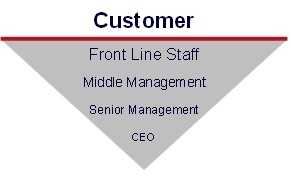The Moment of Truth is the short timeframe when a customer experiences the product or service that many people have often prepared over months. It is the moment when a small, often unintentional mishap has the huge potential to spoil the result of hard work by others in the organisation behind the scenes. Good process managers know this and put their focus on the Moment of Truth.
When Jack Welch explained his view on management he used to draw a company structure against the common understanding upside down. His explanation went somehow like that:
“Who is the most important person for our company? It is our customer. Consequentially, the people who make or break every day’s business are the people who interact most with our customer, our front line staff. The crucial job of the lower management is to make sure their team members at the customer interface have everything they need in order to serve, to impress and to delight the customer. Every level of management has to support their team members with this purpose. My job is to ensure everyone in my company is able and willing to do his best for this objective.”
For many of us this is not really new. However, the number of managers – call them process managers – who really go to Gemba for experiencing the Moment of Truth is marginal.
Is it not enough to ask your staff what is going on at the ground level, what happens at the moment of truth? Well, it would if they knew. And, it is a very normal human tendency that information gets “filtered” when it is passed from hand to hand, from level to level. Often there is a factor of guesswork added to the information.
What We Know About the Moment of Truth
Only an hour after running a very simple role-playing process simulation, the 20 managers involved in the process are asked to state the time spent on their own process steps. They only have to guesstimate the duration for their direct involvement – a non-challenging task, one would assume. To everyone’s surprise the actual time measures more than 300% of the time estimated by the group of managers. Hence, it is not enough to estimate or guess. You need to measure in order to know.
Does this only apply to processes that are new to managers? Not at all. A Lean Six Sigma team’s project focuses on reducing the lead time for treating the customer at a routine service process. During an interim project presentation, the manager who has been directly responsible for that process for many years raised his voice after the team revealed data about the time needed to attend to the customer. He doubted the data; he could not believe that the process took as long as presented. Of cause, the team members were able to show facts… Hence, if you run a process for years, it does not automatically mean you know what happens on the ground. Customers and employees change. And so do processes.
Best Practices
Gemba is the place where your product or service is received and applied. You cannot learn about the Moment of Truth, the usage of your offerings and how well you are able to meet customers’ expectations by conducting an annual survey or by issuing some evaluation forms. CEOs like American Express’ Kenneth Chenault know about this. He is said to spend time in American Express call centres to pick up calls from customers and listen to their requests. He surely cannot change the customer service level by answering some calls every now and then. However, he walks the talk. As a leader, he knows how important it is to observe and focus on what is critical to customers during the Moment of Truth. And, he expects his employees to “have it in their DNA”.
The former CEO of Singapore’s Alexandra Hospital, Liak Teng Lit, used to host a monthly lunch for a focus group of patients who had just gone through Alexandra’s service. He wanted to hear them out about their experience at the Moment of Truth. This way he learned about hospital processes and how his customers perceive them. Whenever possible, he would look into improving things.
Conclusion
For managing a process successfully it is essential to know the details about the process. This can only be achieved by a set of carefully crafted instruments put in place:
- Make sure your process management is based on meaningful process indicators. These are fed with real data collected in the right way by people who are taught to do so. Start with the Moment of Truth.
- Ensure that this information reaches you without being filtered or otherwise manipulated.
- Derive actions based on systematic and comprehensive data analysis following known and accepted rules.
- Publish this information in an appropriate manner so that the organisation can learn from it.
And, don’t forget the go to Gemba from time to time to observe what happens at the Moment of Truth. The purpose of this is two-fold: Firstly, it helps you getting real information from the ground regularly. Secondly, it sends the right signal to your team members, your colleagues and, last but not least, to your customers.
Moreover, it is very likely that you learn something new about your process.


